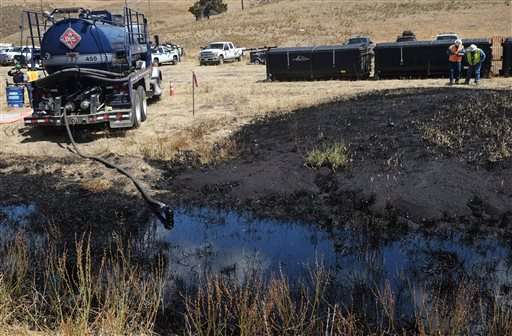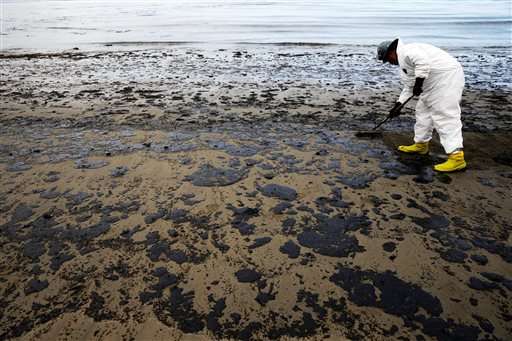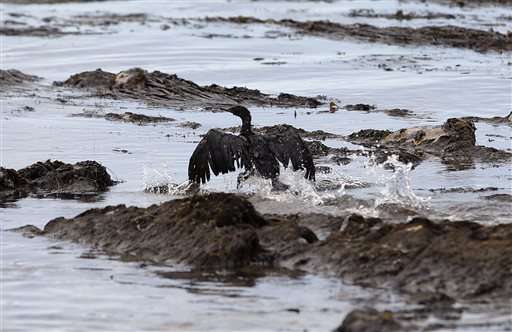EPA says first day of oil spill spent 'planning'

On the afternoon of the largest coastal oil spill in California in 25 years, graduate student Natalie Phares quickly organized a volunteer bucket brigade to clean a beach north of Santa Barbara.
When she arrived about five hours after discovery of the spill, she was surprised to find her small crew alone on the sand a half-mile east of Refugio State Beach, where the spill occurred. Aside from a couple of boats skimming oil from the surface, she didn't see any other cleanup effort.
"It was disheartening," she said. Using headlamps, the 10 volunteers filled 91 buckets in three-and-a-half hours.
"As impressive as those 91 buckets looked, it didn't make a dent," she said.
Phares' experience was echoed by other volunteers who responded in the hours after the May 19 spill that sent up to 101,000 gallons of crude oil down a culvert and onto the beach. An estimated 21,000 gallons went into the Pacific and quickly spread.
California's U.S. senators issued a statement Thursday calling the response insufficient and demanding Plains All American Pipeline explain what it did, and when, after firefighters discovered the leak from the company's underground, 24-inch pipe.
A diverse range of government agencies, from the Coast Guard to state emergency workers to the Santa Barbara County Fire Department converged on the site after the spill was discovered but little on-the-ground cleanup was done on the first day.
Steve Calanog, the deputy on-scene coordinator with the Environmental Protection Agency, said the first hours were devoted to hatching a plan to clean up the mess, not dispatching workers to the beaches.
Emergency responders needed to get a handle on how many miles of coastline were affected and devise a plan to get oil out of the sand and off rocks, all of which takes time, Calanog said.
"For a disaster like this, in order to be most efficient, we need to be able to size up the situation first in order to effectively develop plans to respond to it," he said.

Rancher Mark Tautrim headed to the beach about 1 mile east of the pipeline break after learning of the spill and was relieved to encounter an unspoiled stretch of surf and sand. But that would soon turn to disappointment—several hours later he returned to the same spot to find what he called "globs and globs of oil."
The following day, Tautrim saw people trying to mop up the beach without protective gear—some were in shorts and flip-flops. He didn't see professional cleanup crews until two to three days after the spill.
"I believe it could have been quicker, but that is me from the outside looking in," he said.
Calanog defended the initial response.
"It's easy to say it didn't happen fast enough if you don't realize what it takes to respond to an oil spill," he said.
There is extensive preparation and planning for potential oil spills along the California coast, where a 1969 oil platform blowout and spill on the same stretch of shoreline helped spawn the modern environmental movement. Plains response plan alone is over 1,000 pages of detailed information on how to quickly and methodically react.
Plains officials and emergency workers had gathered at a fire station near the site on the day of the spill to train for that very emergency. Yet on Thursday, Coast Guard Capt. Jennifer Williams acknowledged the initial response "wasn't overwhelming."
"I think that's somewhat typical that it takes a while to get ramped up and get all the assets you need or to even know about the scope of the problem," she said. "Because sometimes you don't even realize how bad it is and then, of course, you're fighting the environmental factors. So the longer you wait, or the longer it takes, the bigger the problem you have because on water it spreads out."

Plains said in a statement that after the release was confirmed, the company immediately activated its emergency response plan and moved "critical resources" to the scene.
"We train regularly for situations such as this, hoping that they will never happen. However, in a real event, no one is fully satisfied with the speed of response," the company said.
Sens. Barbara Boxer and Dianne Feinstein, both Democrats, have called on federal regulators to determine if Plains detected and reported the spill as quickly as possible. "These delays could have exacerbated the extent of the damage to the environment," the senators wrote.
Santa Barbara County Supervisor Salud Carbajal was on the site the morning after the spill, where oil-slicked waves were crashing onshore and rocks were coated with black muck. Looking along a long stretch of beach, he saw a few clusters of workers, numbering about a dozen or so in each group.
"When you consider the gravity of the situation, I did think of whether that was an adequate response or not," Carbajal said.
© 2015 The Associated Press. All rights reserved.





















